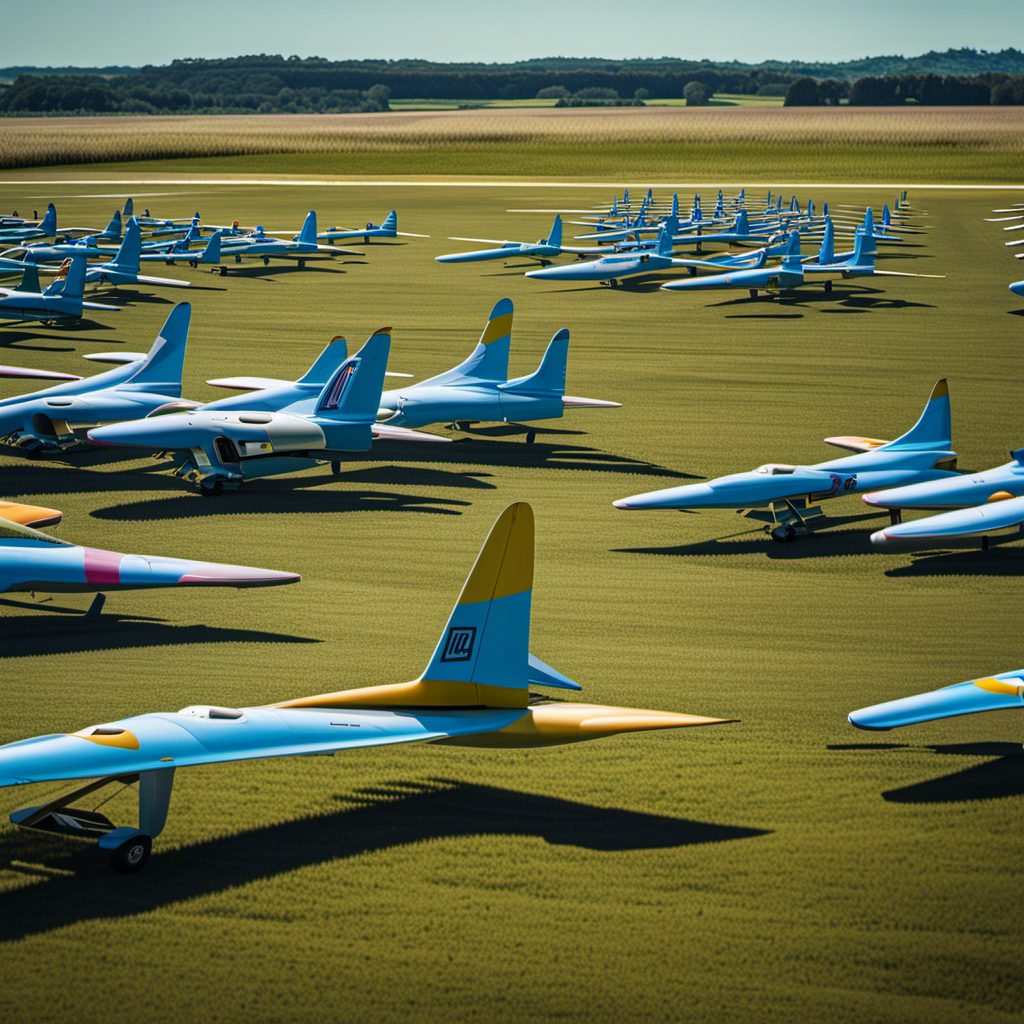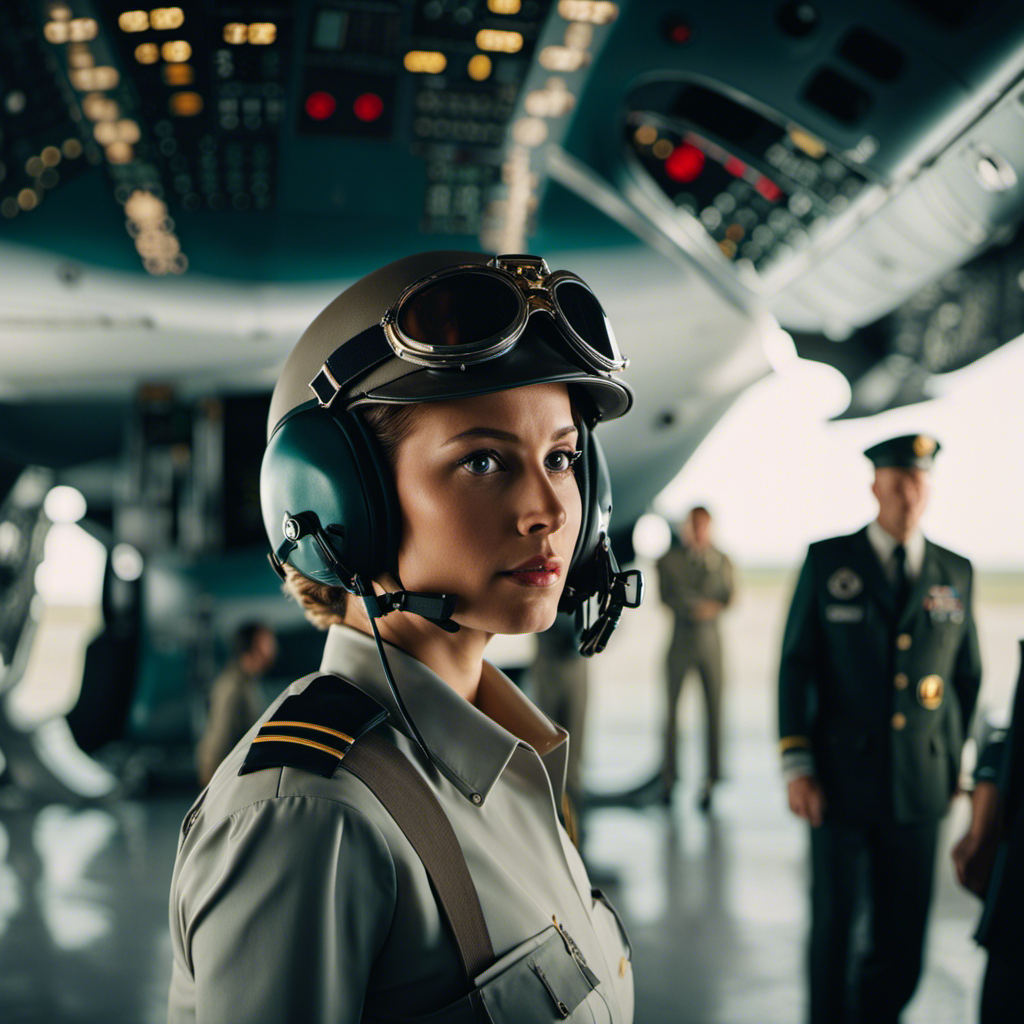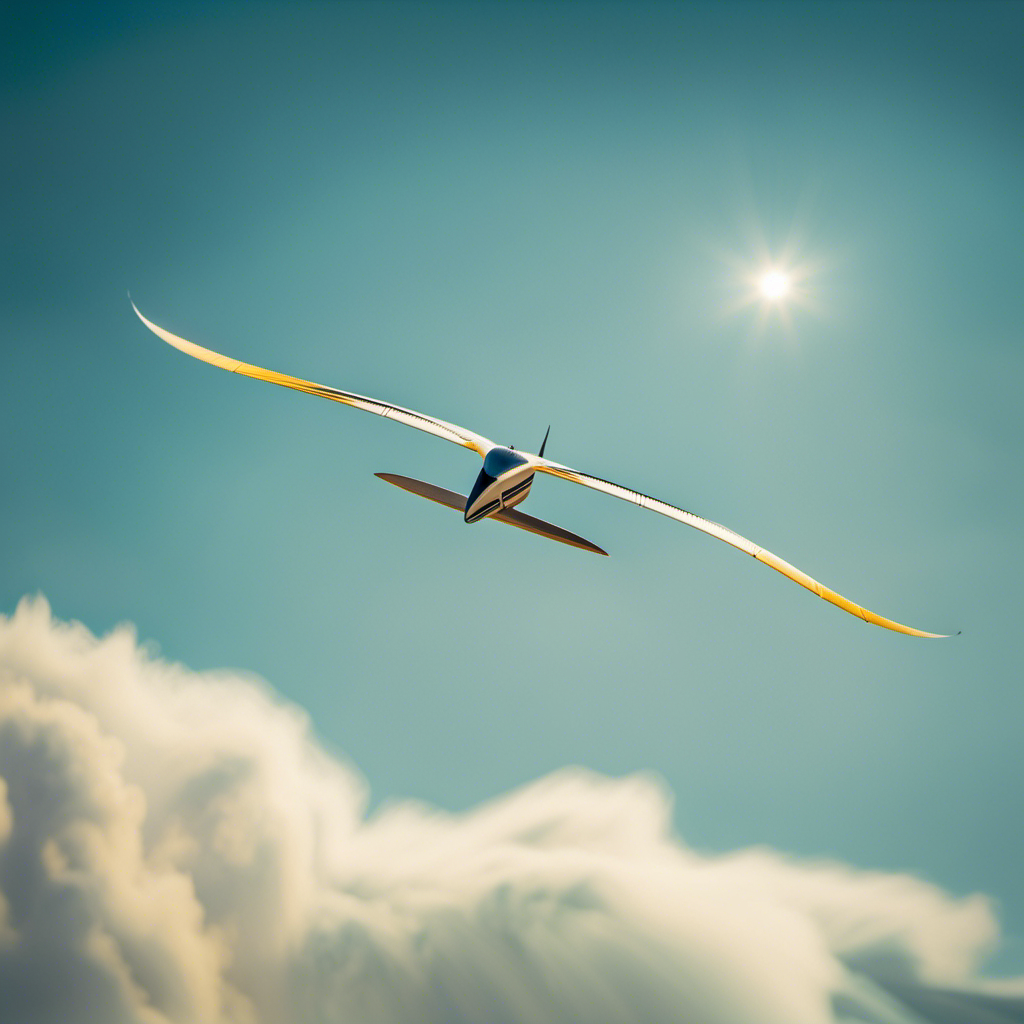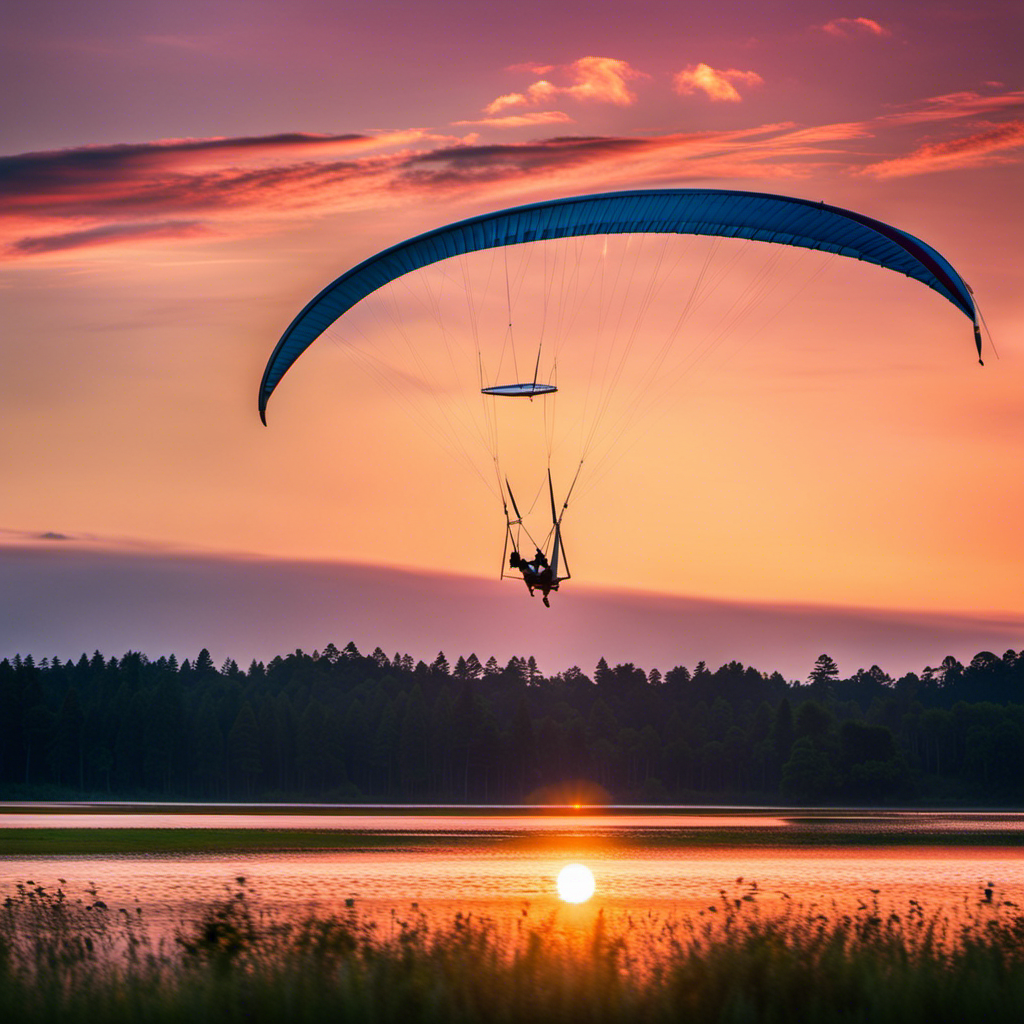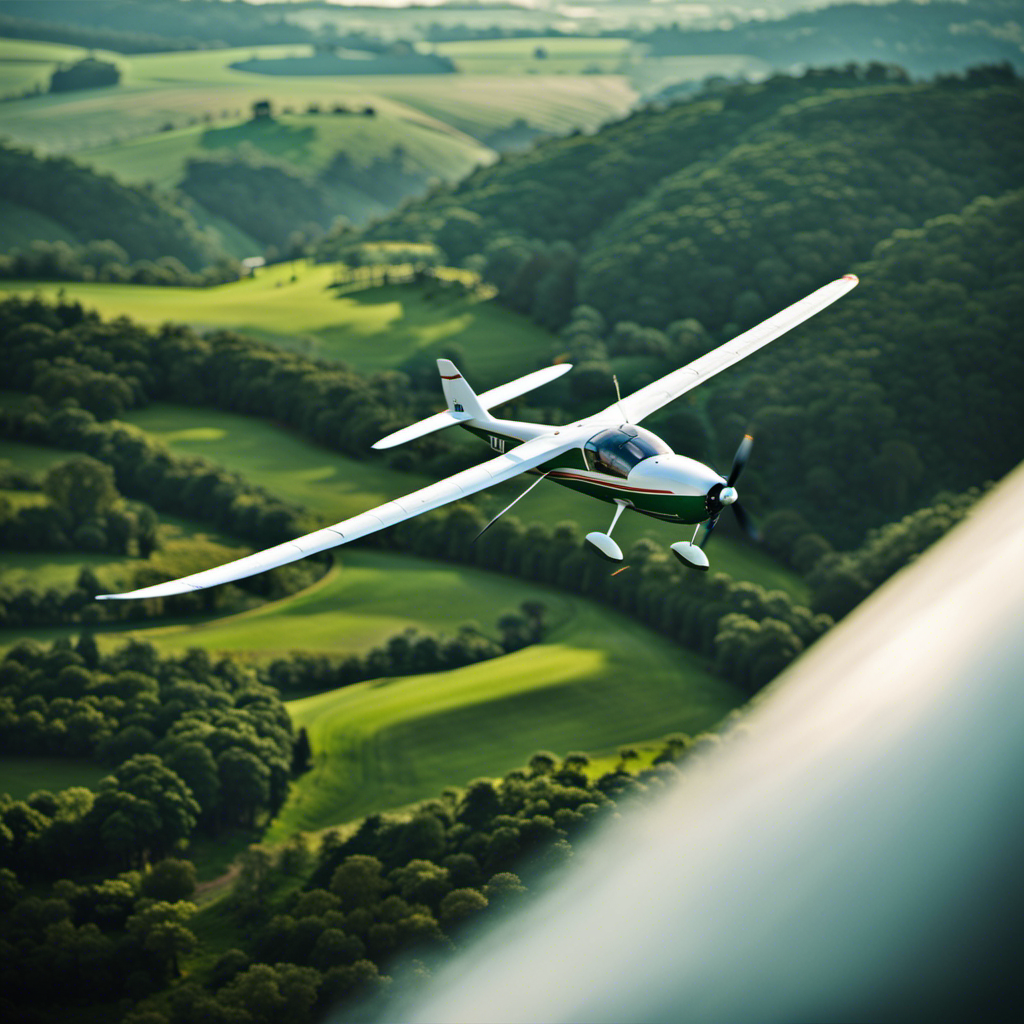As someone who flies gliders, I often get asked the same question: do gliders need fuel?
It’s a fascinating topic that delves into the mechanics of gliding, the design and construction of gliders, and the art of launching and flying without the aid of an engine.
In this article, we will explore the intricate world of gliding, uncovering the benefits and advantages of this sport, the instruments and controls used, and the thriving communities that exist around gliding clubs.
Join me on this journey as we discover the captivating world of gliders and the future that lies ahead.
Key Takeaways
- Gliders do not need fuel as they utilize air currents to stay in the air.
- Lift is generated by the shape of the wings and the pressure difference between the top and bottom surfaces of the wings.
- Gliders are made from lightweight yet strong materials like carbon fiber and fiberglass.
- Gliding is a sustainable and environmentally friendly form of aviation.
The Mechanics of Gliding
You don’t need fuel to glide because gliders use air currents to stay in the air. The mechanics of lift and glider aerodynamics play a crucial role in enabling gliders to soar through the sky without an engine.
Lift is generated by the shape of the wings and the air flowing over them. As the glider moves forward, the air passing over the wings creates a pressure difference, with lower pressure on the top surface and higher pressure on the bottom surface. This pressure difference generates lift, allowing the glider to stay airborne.
By manipulating the glider’s control surfaces, such as the ailerons and elevators, pilots can adjust the distribution of lift and control the glider’s movements. Understanding the mechanics of lift and glider aerodynamics is essential for safe and efficient gliding.
Now, let’s transition into the subsequent section about glider design and construction.
Glider Design and Construction
Glider design and construction involves careful planning and consideration of various factors. To ensure optimal performance and safety, glider materials and aerodynamics principles play a crucial role. Here are three essential aspects to consider:
-
Materials: Gliders are typically made from lightweight yet strong materials such as carbon fiber, fiberglass, and Kevlar. These materials offer a high strength-to-weight ratio, allowing for efficient flight and maneuverability.
-
Wing Design: The shape and size of the wings are designed to generate lift and reduce drag. The wings are usually long and slender, with a curved upper surface and a flatter lower surface. This asymmetrical shape creates a pressure difference, enabling the glider to stay airborne.
-
Control Surfaces: Gliders are equipped with control surfaces like ailerons, elevators, and rudders. These surfaces allow pilots to control the glider’s roll, pitch, and yaw, ensuring stability and maneuverability.
By understanding these key factors, glider designers can create aircraft that are optimized for soaring through the skies.
Now, let’s delve into the thrilling world of launching and flying a glider.
Launching and Flying a Glider
When it comes to launching a glider, there are two main methods: tow launching and winch launching.
Tow launching involves being towed into the air by a powered aircraft, while winch launching uses a high-tension cable and winch to rapidly accelerate the glider.
Once in the air, soaring techniques such as ridge soaring, thermal soaring, and wave soaring can be employed to sustain and gain altitude, allowing for longer and more dynamic flights.
Tow Launching
Once in the air, it’s important to maintain a steady climb during tow launching. The tow rope is securely attached to the glider and the tow plane, allowing the glider to be pulled into the sky. As the tow plane accelerates, the glider begins to rise, and the pilot must carefully control the climb rate to ensure a safe ascent.
The launch altitude varies depending on factors such as wind conditions and runway length, but typically ranges between 1,000 and 2,000 feet above the ground. It’s crucial to maintain a consistent climb rate and stay in sync with the tow plane to avoid any sudden jerks or slack in the tow rope.
This smooth and controlled ascent prepares the glider for the next phase of flight: winch launching, which involves a different method of launching without the use of a tow plane.
Winch Launching
To achieve a successful winch launch, the pilot must maintain a steady climb rate and synchronize with the winch operator.
Winch launching is a popular method used to get gliders airborne quickly and efficiently. The winch itself is a powerful device that uses a high-strength cable to rapidly pull the glider into the air. Proper winch maintenance is crucial to ensure the safety and reliability of the launch. Regular inspections of the winch drum, cable, and control system are necessary to prevent any malfunctions during the launch.
When it comes to winch launching techniques, the pilot must be attentive and responsive to the winch operator’s signals. Clear communication and precise coordination between the pilot and winch operator are essential for a successful launch.
Soaring Techniques
To maximize your flight time and stay aloft in a glider, you’ll need to master various soaring techniques. Here are four essential techniques to help you soar like a pro:
-
Thermal Soaring: Thermals are columns of rising warm air that provide lift for gliders. By circling within a thermal, you can gain altitude and extend your flight.
-
Ridge Lift: When wind encounters a ridge or mountain, it is forced upward, creating a lift zone. By flying close to the ridge and utilizing this upward draft, you can stay airborne without losing altitude.
-
Wave Lift: In certain weather conditions, wind can create long, stationary waves in the atmosphere. By riding these waves, you can achieve significant altitude gain and extend your flight time.
-
Dynamic Soaring: This technique involves using the energy from wind shear or turbulence to gain speed and altitude. By maneuvering your glider in the right areas, you can take advantage of these energy sources.
Mastering these soaring techniques will greatly enhance your gliding experience and allow you to stay aloft for extended periods.
Now, let’s move on to the next section about glider instruments and controls.
Glider Instruments and Controls
When it comes to flying a glider, there are several key instruments and controls that play a crucial role in ensuring a safe and efficient flight.
The variometer and airspeed indicator provide important information about the glider’s rate of climb or descent and its speed through the air, respectively.
The elevator and aileron controls, on the other hand, allow the pilot to maneuver the glider in different directions, while the flaps and spoilers help in controlling the glider’s lift and drag during takeoff and landing.
Variometer and Airspeed Indicator
Check your variometer and airspeed indicator to ensure you have the necessary information for your glider flight. The variometer is a crucial instrument that measures the rate of climb or descent of the glider. It helps the pilot identify thermals and determine the most efficient flight path. Variometer applications include finding lift, optimizing energy management, and improving overall flight performance.
The airspeed indicator, on the other hand, provides the pilot with the glider’s current airspeed. It is important to calibrate the airspeed indicator before each flight to ensure accurate readings. By maintaining proper calibration, the pilot can make informed decisions regarding speed adjustments and control inputs during flight.
Now that we have discussed the variometer and airspeed indicator, let’s move on to the next topic: elevator and aileron controls.
Elevator and Aileron Controls
The elevator and aileron controls are essential for maneuvering the glider during flight. The elevator, located on the tail, is responsible for controlling the pitch of the glider, allowing it to climb or descend. Elevator sensitivity refers to how responsive the elevator is to pilot input. A highly sensitive elevator can provide quick and precise adjustments, while a less sensitive one may require more input from the pilot.
On the other hand, ailerons, located on the wings, control the roll of the glider. Aileron effectiveness determines how much control authority they have in rolling the glider. Effective ailerons can provide better maneuverability and responsiveness in turns. Understanding and properly utilizing both elevator sensitivity and aileron effectiveness are crucial for safe and efficient glider operation.
Now, let’s move on to the next section about flaps and spoilers, which play a vital role in glider performance.
Flaps and Spoilers
To improve your glider’s performance, you can engage the flaps and spoilers. Flaps are hinged surfaces on the wings that can be lowered to increase lift. Spoilers, on the other hand, are devices that disrupt the flow of air over the wings, reducing lift. By using these control surfaces effectively, pilots can optimize their glider’s aerodynamic efficiency and enhance their glide ratio. The table below provides a comparison of flaps and spoilers in terms of their functions and effects on landing techniques and glide ratio improvement.
| Control Surface | Function | Effect on Landing Techniques | Effect on Glide Ratio Improvement |
|---|---|---|---|
| Flaps | Increase lift | Shortens landing roll, allows steeper approach angles | Improves glide ratio by extending wing area and reducing drag |
| Spoilers | Reduce lift | Increases rate of descent, facilitates precise landings | Reduces glide ratio by increasing drag |
Gliding Competitions and Records
You can compete in gliding competitions and set records to showcase your skills as a glider pilot. Gliding competitions provide a platform for pilots to demonstrate their mastery of gliding techniques and push the limits of glider performance.
These competitions often involve tasks such as flying specified routes, achieving specific altitudes, or staying aloft for extended periods. Pilots must employ various gliding techniques, such as thermaling, ridge soaring, and wave riding, to maximize their glider’s performance and cover the required distance efficiently.
The glider’s performance, including its glide ratio, stall speed, and maneuverability, plays a crucial role in determining the pilot’s success in these competitions. Achieving records in gliding competitions not only highlights the pilot’s skill but also helps advance the field of gliding by pushing the boundaries of what is possible in terms of glider performance.
Now let’s move on to safety considerations in gliding.
Safety Considerations in Gliding
When gliding, it’s important to prioritize safety by thoroughly inspecting your glider before each flight. Following safety regulations and being prepared for emergency procedures can greatly reduce the risks involved in this exhilarating sport.
Before taking off, it is crucial to check all the essential components of the glider, such as the wings, control surfaces, and landing gear. Regular maintenance and adherence to safety guidelines ensure that the glider is in optimal condition for flight.
In case of an emergency, knowing the correct procedures can be life-saving. This includes actions to take in the event of a stall, spin, or loss of control. By being diligent about safety and being well-versed in emergency procedures, gliders can be enjoyed with peace of mind.
Transitioning into the subsequent section about the benefits and advantages of gliding, it is clear that prioritizing safety allows for the full enjoyment of this incredible activity.
Benefits and Advantages of Gliding
When it comes to gliding, there are several key advantages that make it an appealing choice.
Firstly, the low operating costs of gliders make it an affordable option for enthusiasts.
Additionally, gliders offer a quiet and eco-friendly flying experience, as they do not rely on fuel or emit harmful emissions.
Lastly, gliding provides a unique thrill and a sense of freedom that cannot be replicated in other forms of aviation.
Low Operating Costs
With low operating costs, gliders don’t require fuel to fly. This makes gliding a cost-effective option for aviation enthusiasts.
Apart from the initial purchase and maintenance, gliders have low maintenance requirements, resulting in further cost savings. The absence of an engine eliminates the need for fuel, reducing operational expenses significantly. Additionally, gliders have fewer moving parts compared to powered aircraft, reducing the risk of mechanical failures and the associated maintenance costs.
This low maintenance aspect makes gliding an attractive option for pilots looking for a more affordable way to enjoy flying.
Furthermore, gliders offer a serene and eco-friendly flying experience, with their silent and emission-free flights. The tranquility and environmental friendliness of gliding add to the overall appeal of this unique form of aviation.
Quiet and Eco-Friendly Flying
To experience quiet and eco-friendly flying, you’ll appreciate the silent and emission-free flights of gliders. Gliders are a prime example of quiet aviation and sustainable travel. Unlike powered aircraft, gliders do not require any fuel to stay aloft. Instead, they rely on the natural forces of the atmosphere, such as thermals and updrafts, to keep them flying.
This not only makes gliders incredibly quiet but also eliminates the need for burning fossil fuels and producing harmful emissions. Gliders offer a peaceful and serene flying experience, allowing you to connect with nature and enjoy the beauty of the sky without any noise or pollution.
Now, let’s delve into the thrill and freedom of gliding.
Thrill and Freedom of Gliding
Experience the exhilarating thrill and unparalleled sense of freedom that comes with gliding through the sky. Gliding, also known as sailplane flying, is a popular activity among thrill-seeking enthusiasts who crave the excitement of soaring through the air without an engine. But gliding is not just about the adrenaline rush. It can also be a form of meditation, offering a serene and peaceful experience as you glide through the clouds. In fact, many gliders describe the sensation of flying as a form of meditation, allowing them to disconnect from the world below and focus solely on the present moment.
To emphasize the different aspects of gliding, let’s take a look at this table:
| Thrill-Seeking Enthusiasts | Gliding as a Form of Meditation |
|---|---|
| Seek excitement and adrenaline rush | Find peace and tranquility |
| Crave the thrill of flying without an engine | Enjoy the serenity of soaring through the sky |
| Thrive in high-speed maneuvers and aerobatics | Appreciate the gentle and graceful movements of the glider |
| Enjoy the challenge of flying in various weather conditions | Embrace the unpredictability of nature |
| Seek camaraderie among fellow thrill-seekers | Connect with like-minded individuals who value mindfulness |
As you can see, gliding offers something for everyone, whether you’re a thrill-seeker or someone seeking a meditative experience. Now, let’s delve into the world of gliding clubs and communities, where enthusiasts come together to share their love for this exhilarating and liberating sport.
Gliding Clubs and Communities
Joining gliding clubs and communities can provide you with a supportive and enthusiastic network of fellow glider pilots. Gliding clubs are organizations dedicated to promoting and advancing the sport of gliding. They offer a variety of benefits, such as access to glider rentals, training programs, and social events. By becoming a member of a gliding club, you can connect with experienced pilots who can share their knowledge and expertise.
Additionally, gliding communities provide a platform for glider pilots to interact, exchange ideas, and organize group flights. These communities often have online forums, social media groups, and local meetups where pilots can connect and collaborate. Being part of a gliding club or community can enhance your gliding experience and facilitate your growth as a glider pilot.
Transitioning into the next section, gliding as a sport and recreational activity offers a unique blend of adventure and serenity.
Gliding as a Sport and Recreational Activity
When you’re gliding, you’ll feel a sense of freedom and exhilaration as you soar through the sky, relying solely on the power of the wind. Gliding as a sport and recreational activity offers unique challenges and rewards. To engage in this thrilling pursuit, it is essential to have the right gliding equipment and master various gliding techniques.
Here is a table highlighting some important gliding equipment and techniques:
| Gliding Equipment | Gliding Techniques |
|---|---|
| Glider | Launching |
| Parachute | Thermalling |
| Radio | Ridge Soaring |
| Instruments | Cross-Country |
| Tow Plane | Speed-to-Fly |
The glider, parachute, radio, instruments, and tow plane are all crucial components of a successful gliding experience. Meanwhile, launching, thermalling, ridge soaring, cross-country, and speed-to-fly techniques are essential skills that every glider pilot must master.
As we look towards the future of gliding, advancements in technology and aerodynamics will continue to shape this sport. The next section will explore how these developments will revolutionize gliding without the need for fossil fuels.
The Future of Gliding
As I envision the future of gliding, advancements in technology and aerodynamics will revolutionize this sport by eliminating the need for fossil fuels. The development of sustainable measures in gliding will pave the way for a more environmentally friendly and efficient form of flying.
Future advancements will focus on harnessing renewable energy sources, such as solar power, to provide the necessary energy for gliders. By integrating solar panels into the wings and fuselage, gliders will be able to generate electricity and store it in lightweight batteries.
Additionally, advancements in aerodynamics will optimize the glider’s design, reducing drag and increasing efficiency. These improvements will not only make gliding more sustainable but also enhance performance, allowing gliders to stay aloft for longer periods and explore new heights and distances.
The future of gliding holds great promise, combining technological advancements and sustainability measures to create a truly remarkable experience.
Frequently Asked Questions
How much fuel does a glider typically use during a flight?
During a flight, gliders do not use any fuel as they rely solely on the energy from the surrounding air to stay airborne. This makes gliders extremely fuel-efficient and environmentally friendly compared to powered aircraft.
What are the environmental impacts of gliding compared to other forms of aviation?
Gliding offers significant environmental benefits compared to other forms of aviation. It is a sustainable aviation option that produces zero emissions and has minimal noise pollution, making it a more environmentally friendly choice.
Can gliders be equipped with engines or motors for additional power?
Yes, gliders can be equipped with engines or motors for additional power. This allows them to take off without the need for a tow plane or a hill launch, increasing their independence and versatility.
Are there any limitations on where gliders can fly?
There are limitations on where gliders can fly, known as glider flight areas. These areas are defined by regulations and airspace restrictions to ensure the safety of both glider pilots and other aircraft.
How long can a glider stay in the air without using any fuel?
A glider can stay in the air without using any fuel for extended periods of time, thanks to its efficient design and the skill of the pilot. Glider endurance depends on factors such as weather conditions and altitude.
Conclusion
In conclusion, gliding is a remarkable sport that showcases the power of human ingenuity and the beauty of our natural world.
As a glider soars through the sky, it represents freedom, grace, and the ability to overcome obstacles. It symbolizes our endless quest for exploration and the pursuit of our dreams.
Gliding requires skill, precision, and a deep understanding of aerodynamics, making it a challenging yet rewarding endeavor.
With advancements in technology, the future of gliding looks promising, as we continue to push the boundaries of what is possible in the world of aviation.
Orion, better known as “Jetstream,” is the voice that brings the stories of the skies to life. His fascination with aviation began at a young age, sparked by his father’s tales of flying and adventure. Orion’s journey into the world of gliding was serendipitous, and from the moment he took his first glider flight, he knew he had found his calling.

